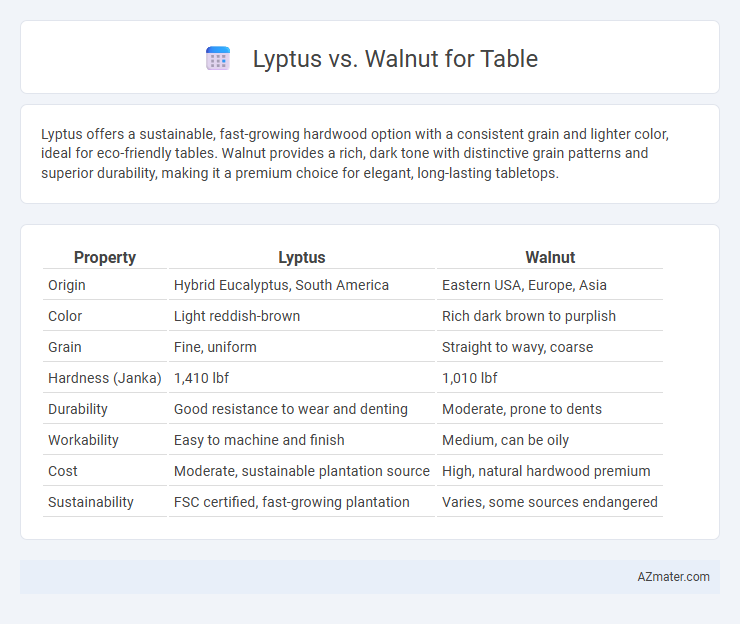Lyptus offers a sustainable, fast-growing hardwood option with a consistent grain and lighter color, ideal for eco-friendly tables. Walnut provides a rich, dark tone with distinctive grain patterns and superior durability, making it a premium choice for elegant, long-lasting tabletops.
Table of Comparison
| Property | Lyptus | Walnut |
|---|---|---|
| Origin | Hybrid Eucalyptus, South America | Eastern USA, Europe, Asia |
| Color | Light reddish-brown | Rich dark brown to purplish |
| Grain | Fine, uniform | Straight to wavy, coarse |
| Hardness (Janka) | 1,410 lbf | 1,010 lbf |
| Durability | Good resistance to wear and denting | Moderate, prone to dents |
| Workability | Easy to machine and finish | Medium, can be oily |
| Cost | Moderate, sustainable plantation source | High, natural hardwood premium |
| Sustainability | FSC certified, fast-growing plantation | Varies, some sources endangered |
Introduction to Lyptus and Walnut for Tables
Lyptus, a hybrid eucalyptus species, is prized for its uniform grain, high durability, and eco-friendly harvesting methods, making it an excellent choice for sustainable furniture production. Walnut, known for its rich, dark color and natural grain patterns, offers exceptional strength and a luxurious appearance favored in high-end table craftsmanship. Both woods provide distinct aesthetics and performance qualities, with Lyptus emphasizing sustainability and walnut delivering timeless elegance.
Lyptus Wood: Characteristics and Benefits
Lyptus wood, a hybrid eucalyptus species, offers a dense, hard surface ideal for durable tabletops, featuring a rich reddish-brown color that deepens with age. Its natural resistance to wear and moisture makes it highly suitable for everyday use, while its sustainable harvesting from fast-growing plantations ensures an eco-friendly choice. Compared to walnut, Lyptus provides a cost-effective alternative without sacrificing strength or aesthetic appeal.
Walnut Wood: Features and Advantages
Walnut wood is prized for its rich, deep brown color with subtle purple hues and a fine, straight grain that enhances the aesthetic appeal of tables. It offers exceptional durability, resistance to wear, and natural stability, making it ideal for furniture that withstands daily use. Walnut's ability to take polish well creates a smooth, elegant finish that highlights its natural beauty and adds value to any table.
Comparing Appearance: Lyptus vs Walnut
Lyptus wood exhibits a consistent, light reddish-brown hue with subtle grain patterns, offering a smooth and uniform appearance ideal for modern furniture designs. Walnut features rich, deep chocolate-brown tones with distinctive swirling grain and occasional purple streaks, enhancing its luxurious and classic aesthetic. The contrasting visual characteristics of Lyptus and Walnut allow for diverse stylistic choices when selecting wood for tables.
Durability and Strength of Lyptus vs Walnut
Lyptus wood offers impressive durability with a Janka hardness rating of approximately 1,660, making it highly resistant to dents and scratches, while walnut has a slightly lower hardness rating around 1,010, providing moderate resistance. In terms of strength, Lyptus is known for its dense grain structure and stability, delivering strong performance under weight and pressure compared to walnut's softer, more porous composition. These characteristics make Lyptus a more robust option for tables expected to endure heavy daily use without compromising structural integrity.
Workability and Ease of Crafting
Lyptus wood offers superior workability due to its uniform grain and consistent density, making it easier to cut, sand, and shape compared to walnut. Walnut, prized for its rich color and natural vary, requires more care during crafting to avoid tear-out and to achieve a smooth finish. Both woods respond well to hand and power tools, but lyptus is often preferred for precision work due to its predictable machining properties.
Cost and Availability Considerations
Lyptus wood offers a cost-effective alternative to walnut, with prices generally lower due to its faster growth cycle and sustainable plantation sourcing. Walnut is often more expensive and less readily available because it grows slower and is harvested from older, natural forests. Both woods are accessible in North America; however, lyptus provides more consistent supply due to its plantation origins, making it ideal for budget-conscious furniture projects.
Environmental Impact and Sustainability
Lyptus wood originates from fast-growing Eucalyptus trees cultivated in managed plantations, promoting sustainable forestry practices with minimal deforestation. Walnut, typically harvested from slower-growing hardwood forests, often involves longer growth cycles and can contribute to habitat disruption if not sourced responsibly. Choosing Lyptus over Walnut supports reduced carbon footprint and enhanced environmental sustainability due to its rapid renewability and efficient plantation management.
Best Use Cases: Which Wood Suits Your Table?
Lyptus offers a durable, sustainable hardwood ideal for modern dining tables requiring resistance to scratches and moisture, making it suitable for families with children or high-traffic areas. Walnut's rich, deep grain and natural warmth provide a luxurious aesthetic perfect for formal dining rooms or statement pieces where visual appeal and fine craftsmanship are paramount. Choosing between Lyptus and Walnut depends on balancing practical durability against sophisticated beauty to match the table's intended function and style.
Final Verdict: Choosing Between Lyptus and Walnut
Lyptus offers a sustainable, cost-effective alternative with a lighter color and uniform grain, making it ideal for modern, budget-conscious table designs. Walnut, prized for its rich, dark tones and natural grain patterns, provides a luxurious, durable surface favored in high-end furniture. Selecting between Lyptus and Walnut ultimately depends on balancing environmental impact, aesthetic preference, and budget constraints for the intended table use.

Infographic: Lyptus vs Walnut for Table
 azmater.com
azmater.com